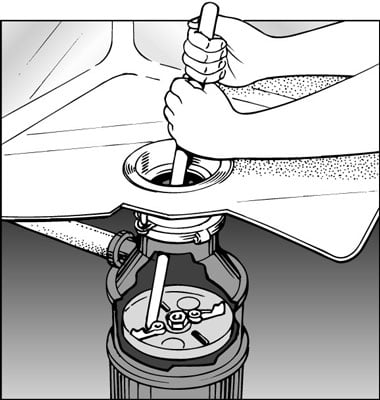-
Dropping a foreign object — usually a spoon or fork — into the disposal
-
Feeding garbage in too rapidly
-
Failing to run enough water (to completely flush out the drainpipes) while garbage is being processed
Never use chemical drain cleaners in a disposal. The chemicals are highly corrosive and may damage rubber or plastic parts.
Use Mother Nature’s deodorizer for your disposal: Every few months, cut a lemon in half, throw one half in the disposal, turn on the unit, and let it run for a minute or two. The lemon removes the build-up of residue on the interior of the disposal and deodorizes the unit. You know it’s working by the fresh lemony smell.Steps for unclogging the disposal
If the instructions in your user’s manual are no help, follow these steps to unclog a disposal:-
Shut off the electrical power switch.
This switch is located under the cabinet, near the disposal, or on a wall nearby. If you don’t find a switch, go to the main power panel and turn off the breaker or remove the fuse that powers the disposal.
Never put your hand in the disposal. Remember that the switch may be defective, so keep your hands out of the disposal even when power to the machine is turned off.
-
Take a look in the disposal.
A flashlight may shed some light on the problem — you may see a large object caught in the disposal.
-
If an object caused the stoppage, use a pair of pliers to reach into the disposal and remove it.
-
Wait 15 minutes for the disposal motor to cool.
-
Turn on the power and push the reset or overload protector button.
This button is located on the bottom of the disposal.
-
Turn off the power and insert a long dowel, a wooden spoon, or a broom handle — never your hand — into the drain opening.
-
Push the bottom end of the wooden probe against the impeller (the blades that grind up the garbage) and rock it back and forth to free it.

-
When the impeller moves freely, wait 15 minutes for the motor to cool, turn on the power, and push the reset button.

